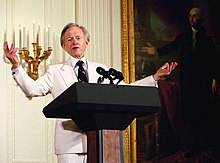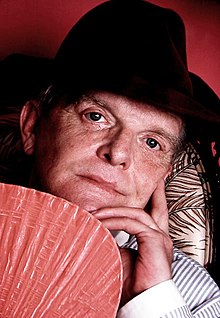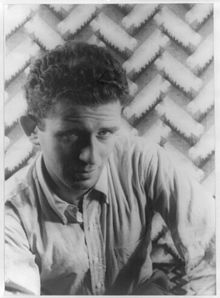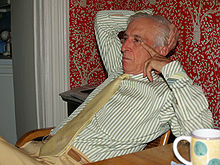New Journalism

The term New Journalism is understood to mean a writing and reporting style that emerged in the USA in the 1960s and 1970s . He deviated from the usual journalistic practice insofar as he proceeded in a highly subjective manner, increasingly resorted to literary stylistic devices and still stuck to the facts. The usual demarcation between literature and journalism has been shifted.
Concept formation
Whether the term "New Journalism", as is often claimed, was brought into play in 1887 by Matthew Arnold or later by Tom Wolfe is irrelevant and does not matter because the adjective "new" is not a serious one anyway Category, but rather a distinguishing feature owed to the marketing idea, which is intended to set the new cross-border commuters apart from the traditional.
On the relationship between literature and journalism
Literature as a whole “everything recorded in writing” also includes articles from the daily business of journalism. Both journalists and the former writers mentioned writers have always shared one thing: Would you and publish texts .
The texts of both areas differ in the following: "Journalistic texts are non- fictional and up-to-date, literary texts are fictional and timeless".
In spite of this general difference, which in the course of history has brought "journalism the reputation of being inferior and writing the myth of the only true art, literature and journalism have common roots." Both the works of writers and the articles of journalists are "In principle always aimed at a public ".
As Jürgen Enkemann was able to demonstrate using the example of English literary history, phases of strict delimitation of the two areas alternated again and again with phases of mutual fertilization.
What's new about New Journalism
So it happens again and again - as the "New Journalism" shows in our time - that the existing canon of what is to be classified as "journalistic" and what is to be classified as "literary" is productively violated. In this way, the authors of “New Journalism” also developed new hybrid forms in the relationship between literature and journalism that were previously unfamiliar.
In terms of content, all these authors turned to those areas that traditional journalism had previously neglected: pop music , the drug scene , subculture in general and various types of sport . In addition, there was a way of dealing with politics, which in this radicalism differed greatly from previous political reporting. The authors in question also deviated from the usual journalistic practice in their "spelling" insofar as they - although they correctly adhered to facts - formulated their tone of voice in a highly subjective manner and in the first-person form and otherwise made greater use of literary stylistic devices increased literary character .
Specific characteristics
For Tom Wolfe , New Journalism filled a void that had opened up because, in his opinion, the authors of high literature increasingly expressed themselves in incomprehensible language, limited them to purely formal gimmicks and neglected everyday matters. Journalism, on the other hand, according to Wolfe, has withdrawn to an objectivity that has become questionable , in which the desired liveliness is buried under facts.
Important actors
Important representatives of New Journalism - belonging to different generations - are authors such as Lester Bangs , Brock Brower, Truman Capote , Joan Didion , Norman Mailer , George Plimpton , Terry Southern , Gay Talese , Hunter S. Thompson and Tom Wolfe. The literary breadth and diversity is also evident in the habitus , a dandy like Tom Wolfe on one end of the spectrum and a bohemian type like Lester Bangs on the other end of the spectrum - both of which are hailed as America's greatest pop critics.
Important fields of action
Reports and essays by the new journalists have appeared in magazines such as The Atlantic Monthly , Harper's Magazine , Koevolution Quarterly , Esquire , New York and Rolling Stone , and have given the movement a breakthrough, as have the seminal articles by Tom Wolfe :
- The New Journalism .
- The Birth of 'The New Journalism': Eyewitness Report .
- The New Journalism: A la Recherche des Whichy Thickets .
Wolfe also co-wrote the larger work with EW Johnson entitled The New Journalism: With an Anthology Edition . This is one of the reasons why Wolfe is still identified today with the term “New Journalism”.
Culture transfer to Germany
New journalism spread to Germany in the mid-1960s and became known here as pop journalism , not least thanks to influential pop culture magazines such as Sounds and Spex (magazine) .
literature
- Joan Kristin Bleicher , Bernhard Pörksen (Ed.): Grenzgänger. Forms of New Journalism. Verlag für Sozialwissenschaften, Wiesbaden 2004, ISBN 3-531-14096-5 .
- Michael L. Johnson: The new journalism: the underground press, the artists of nonfiction, and changes in the established media. University Press of Kansas, Lawrence 1971. ISBN 0-7006-0083-3
- Thomas Leif (Ed.): New Journalism. From cultural asset to economic asset. Friedrich-Ebert-Stiftung, Bonn 2002. ISBN 3-89892-095-X
- Tom Wolfe / EW Johnson (Eds.): The New Journalism: With an Anthology Edition . Harper & Row, New York 1973. ISBN 0-06-047183-2 .
Web links
- Jakob Augstein : Lover of Life In: Friday
- Article about New Journalism and García Marquez 'Journalism School in Ibero America (German)
See also
Individual evidence
- ↑ See Joan Kristin Bleicher , Bernhard Pörksen (Ed.): Grenzgänger. Forms of New Journalism. Verlag für Sozialwissenschaften, Wiesbaden 2004, ISBN 3-531-14096-5
- ↑ See Bernd Blöbaum / Stefan Neuhaus (eds.): Literature and Journalism. Theory, contexts, case studies . Westdeutscher Verlag, Wiesbaden 2003, p. 11.
- ^ Matthew Arnold, "Visions of the Press, 1850-1950". University of Illinois Press. Hampton, Mark 2004. pp. 35-37, ISBN 0252029461
- ↑ Volker Meid: Specialized dictionary on German literature . Reclam, Stuttgart 1999, paperback edition 2001, p. 304.
- ↑ Cf. Robert Musil: “Literature and literature. Marginal notes on this ”(from 1931). In: Collected works in nine volumes . Edited by Adolf Frisé. Vol. 8: Essays and Speeches . Rowohlt, Reinbek 1978, ISBN 3-499-30008-7 , pp. 1203-1225, here p. 1204
- ↑ See Theo Herrmann / Siegfried Hoppe-Graff: "Textproduktion", in: Gerd Antos / Hans P. Krings (eds.): Textproduktion. An interdisciplinary research overview . Concepts of linguistics and literary studies, Max Niemeyer Verlag, Tübingen 1989, p. 147. ISBN 3-484-22048-1
- ↑ Bernd Blöbaum / Stefan Neuhaus (eds.): Literature and journalism. Theory, contexts, case studies . Westdeutscher Verlag, Wiesbaden 2003, p. 11. Retrieved on April 5, 2015 http://www.uni-koblenz-landau.de/de/koblenz/fb2/inst-germanistik/mitarbeiter/stefan-neuhaus/vontextenmenschenundmedien
- ^ Gabriele Eder: Literature and journalism: a complex network of relationships. Intersections and functional differences in an analytical view , in: Fachjournalist Nr. 20, 2005, p. 23.
- ↑ Cf. Gabriele Eder: Literature and journalism: a complex network of relationships. Intersections and functional differences in an analyzing view , in: Fachjournalist No. 20, 2005, p. 23. http://www.fachjournalist.de/PDF-Dateien/2012/05/FJ_20_2005-Literatur-und-Journalismus_ein-komplexes-Beziehungsgeflecht .pdf
- ↑ See Jürgen Enkemann: Journalism and Literature. On the relationship between the newspaper system, literature and the development of the middle class in England in the 17th and 18th centuries . Tübingen 1983, pp. 23 f., 43 ff. And 63 ff.
- ↑ Cf. on this in a very brief definition http://de.encyclopaedia.wikia.com/wiki/Mischform_(Journalismus)
- ↑ Claudia Benthien: Literarität in der Medienkunst , in: Claudia Benthien / Brigitte Weingart (eds.): Handbuch Literatur & Visuelle Kultur , de Gruyter, Berlin 2014, pp. 265–284.
- ↑ See foreword by Tom Wolfe / EW Johnson (ed.): The New Journalism: With an Anthology Edition . Harper & Row, New York 1973, ISBN 0-06-047183-2 .
- ↑ Cf. Heiner Bus: The American New Journalism of the 60s and 70s. Truman Capote, Michael Herr, Norman Mailer and Tom Wolfe . In: Bernd Blöbaum / Stefan Neuhaus (eds.): Literature and journalism. Theory, contexts, case studies . https://www.uni-koblenz-landau.de/de/koblenz/fb2/inst-germanistik/mitarbeiter/stefan-neuhaus/vontextenmenschenundmedien Retrieved on July 2, 2015
- ^ In: Bulletin of the American Society of Newspaper Editors , September 1970.
- ^ In: New York Magazine , February 14, 1972, pp. 44 f.
- ↑ In: New York Magazine , February 21, 1972. pp. 46 f.
- ↑ Harper & Row, New York 1973, ISBN 0-06-047183-2
- ↑ Jürgen Legath (Ed.): Sounds: Platten 66-77. 1827 reviews . Two thousand and one, Frankfurt am Main 1979.
- ↑ Cf. Max Dax , Anne Waak (Ed.): Spex - 33 1/3 years Pop . Metrolit, Berlin 2013, ISBN 3849300331



